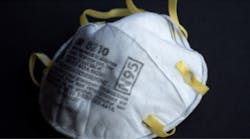Thursday Troubleshooter: What’s proper decontamination of N95 masks?
This column is here to guide dental professionals with advice from the experts . . . because they’ve been there. Remember, you are not alone! Send your questions to [email protected]. Those who reach out will remain anonymous if their questions are used on DentistryIQ.
QUESTION: I appreciated your article on the reuse of N95 masks. It clarified some of my concerns. My question for you now is related to decontamination of the N95s. Decontamination is mentioned several times in the article, but the process is not specified. Could you please clarify this for me? I'm assuming it means sterilization in an autoclave, but I want to make sure that's correct.
ANSWER FROM KAREN DAW: "The OSHA Lady," consultant, and speaker:
You’re 100% correct to question decontamination. In fact, I refrained from discussing reprocessing of N95s in my first response because the Centers for Disease Control and Prevention (CDC) offers alternative strategies that should be considered before decontamination. Of course, when there are enough respirators to go around, they are treated as one-and-done for disposable filtering facepiece respirators (FFR). However, the next steps depend on where your practice is with regard to supply and the ability to obtain supply. Visit this link at the CDC to view the helpful “Flowchart to determine if an N95 FFR crisis capacity strategy is needed.”
The recommendations in times of shortages would be to use N95s past their shelf life, extend use of N95s, use other types of respirators, use respirators from other countries, and reuse of respirators, all before considering decontamination.
In addition, the Occupational Safety and Health Administration (OSHA) states that decontaminating FFRs voids the respirator’s National Institute for Occupational Safety and Health (NIOSH) approval, though they also state that decontamination may be considered if all CDC recommended options have been exhausted. Even then, decontamination must follow the manufacturer’s recommendations for the company’s specific mask model, and manufacturers echo this. For example, a 3M bulletin on decontamination of their FFR states, “The purpose is not to recommend the practice of decontamination or to comment on the efficacy of the decontamination method on the virus that causes COVID-19 or the safety of the decontamination methods for FFR wearers.”
The Food and Drug Administration (FDA) issued the first emergency use authorization (EUA) in March for a process to decontaminate, and subsequent EUAs have been issued. Dental practice staff should check the FDA website for the most up-to-date information. NIOSH also reviewed decontamination of FFRs and found that, as of April 2020, UV germicidal irradiation, vaporous hydrogen peroxide, and moist heat are the most promising methods to decontaminate FFRs. OSHA further states that if these methods are not available, the use of microwave-generated steam and/or liquid hydrogen peroxide may be considered. However, autoclaving, dry heat, dry microwave irradiation, disinfecting wipes, and bleach should be avoided unless sufficient data exists on the safety and success of these methods.
It’s important to know that decontamination does not restore an N95 to “new” performance. In fact, quite the opposite. Repeated decontamination and handling can damage the fit and filtration of FFRs. If the dental team chooses this route, the employer must demonstrate that the decontamination method is effective against SARS-CoV-2, the integrity of the mask has not been compromised, and the method does not produce additional safety hazards. I just assisted a practice where a team member had read that the mask could be placed in the microwave. The mask had metal parts on it. You can imagine how that turned out!
In a nutshell, if all other CDC recommended options have been exhausted, there are manufacturer’s instructions for use (IFU) or third-party data for decontamination. The employer must demonstrate that the decontamination process does not create additional hazards to the user (allergic reaction, breathing problems, skin irritation) or in the workplace. The process must not alter the ability of the mask to protect the user (it passes each user seal check). Then decontamination can be considered for N95s. Stay safe!
To read previous Troubleshooters, visit DentistryIQ and search “Thursday Troubleshooter.” And remember! If you’re having problems in your dental practice, send your question and concerns to Troubleshooter for an expert to address. You’ll be helping others who are experiencing similar issues. Send inquiries to [email protected].





